- Article
tells you about Kerala Murals in some detail.
The
traditional mural paintings of Kerala are a fine art of skill and creative
excellence. Most of the noted mural works of Kerala were done between the 15th
and 19th centuries. They bear a stamp of uniqueness in techniques used and
aesthetics.
A mural is
an artwork painted or applied directly onto walls, ceilings or any other
permanent surface. In murals, architectural elements of the given space are
harmoniously incorporated into its creation. Among murals, the ones from Kerala
stand out for their finesse.
With
the largest collection of murals based on ancient Indian traditions, Kerala is
at par with the state of Rajasthan. Some of the Kerala murals date back to the
8th century. Today the trend has shifted from wall murals to those painted on
canvas and paper.
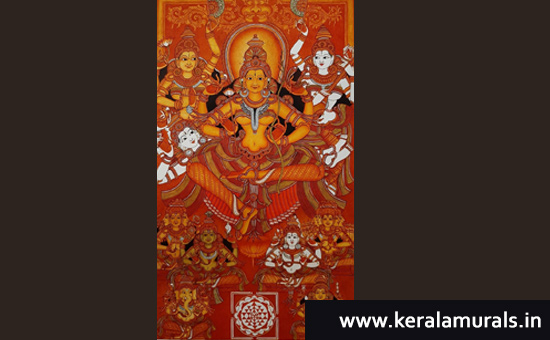
Credits
A Unique Treasure
The
materials used in mural art work like pigments, brushes, gum etc. are made of natural
materials like minerals and plants. The most frequently used pigments in Kerala
murals are saffron-red, saffron-yellow, green, red, white, blue, black, yellow
and golden-yellow.
Every
mural is a testament to the depth of dedication the artists have to their art.
The temples and palaces of Kerala are a visual treat wherein the sagas of
ancient Hindu Gods and Goddesses unfold. The murals of Kerala evolved through
the significant influences of ancient rituals like Kalamezhuthu and Patayani.
The murals of Kerala are unparalleled in their subtlety, sharpness and ethereal
beauty.
The
oldest of the murals found in Kerala are those in the Thirunandikkara Cave
temple now a part of Kanyakumari district in the neighbouring State of Tamil
Nadu. The largest mural panel in Kerala
called the Gajendra Moksha is at the Krishnapuram Palace near Kayamkulam
in Alappuzha district. Extensive murals depicting scenes from the Ramayana and
the Bhagavatha are preserved at the Mattancherry palace in Ernakulam
district. The murals of the Shiva temple at Ettumanoor provide insights into
the earliest forms of Dravidian mural art.
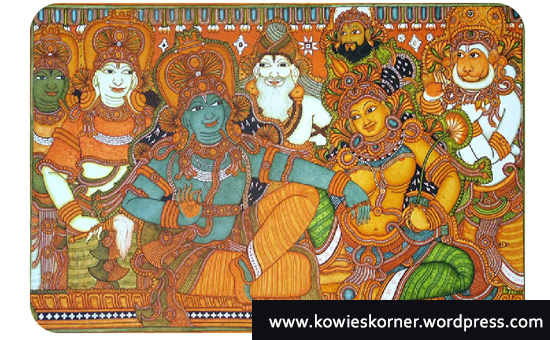
Credits
Kerala Mural Art: Traditional
Procedures to Paint on Walls By Using Natural Materials
Mural
paintings are usually seen in the walls and ceilings of temples and churches.
Earlier Mural forms used natural materials and vegetative colours such as
herbal dyes, fruits juices, and also chemicals obtained from stones and roots
etc. Five colours majorly used are red, yellow, green, black, and white.
Painting brushes are prepared by taking from grass and bamboos. Wooden utensils
are used to mix colours and roller stone is to grind the mudstones to make
pigment paste.
Wall
for traditional murals is done in three stages. The brick wall is a plastered
mixture of lime and clean sand, different treatments are applied to get a
perfect wall for drawing. Yellow outlining is the primary step in sketching
which after followed by a colour filling. The complete space of art is occupied
with different elements and overall painting is symmetrically presented by using
components. Each character depicts the stories of god and goddesses and
coloration for different characters based on three symbolism.
Traditional
mural paintings are mostly prepared at older palaces and temples of Kerala.
Life of mural painting art is practiced and followed by generations with the
support of mural institutes.
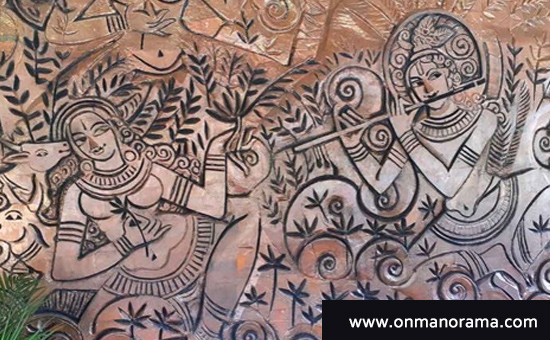
Credits
Making of a Kerala Mural
Painting
Mural
painting was traditionally done on walls of temples. It follows a long process
of preparing the wall for the painting, extracting dyes from leaves, flowers
and vegetables after sun drying them for days, and applying each layered coat
of painting, and giving time before the next coat.
These
days Mural painting using natural dyes can be done on wooded planks and
transported. They are also done using Acrylic paints on canvas.
Here
is how a Mural Painting is done on Canvas.
1.
After the Mural Painting is conceptualised and drawn out with pencil on canvas,
it is prepared with shades of yellow.
2.
The first set of colours are filled in a certain prescribed order.
3.
The darker shades are filled last and that completes the Mural painting.
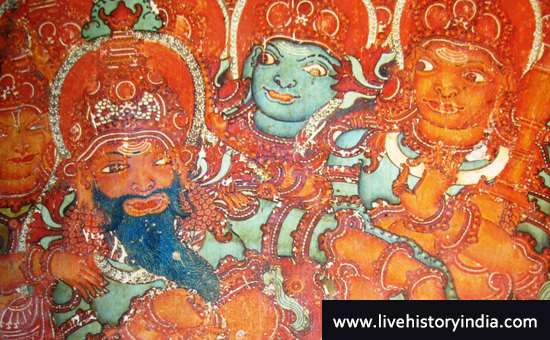
Reference
Visual Appeal
A
Mural Painting has a lot of visualisation, theory, vastu principles
and rules. These are learnt by the artist over the years. There are
proportions that human body and face are to follow, and rules for the skin
colours of various characters. An artist innovates within these boundaries.
It eventually gives a unique and mesmerising feel to Kerala Mural
Paintings.
Motifs of Kerala mural paintings
Usually
Kerala mural paintings depict Hindu traditions and there are certain motifs
that can be seen on all these paintings. These motifs add a traditional touch
to these mural paintings.

Credits
Techniques of Modern Kerala mural
paintings
The
technique of Kerala mural painting is quite simple but time-consuming. There
are six stages in Kerala mural painting.
First
stage is the sketching a design on a white fabric. The second stage is
enhancing the outline of the sketch. Third stage is colouring the painting. The
only step that needs to be followed while painting a Kerala mural is the order
of applying the Panchavarna colours
(yellow, red, green, blue). Fourth stage is applying gradation. Fifth stage is
the application of black outline. Sixth stage is the final and finishing
touches to the painting
Materials and Methods for Modern
Application
The materials used are Acrylic paints, Medium 1 (prevents spreading when mixed with paints), Fabric, Fasteners – Velcro, zipper, magnetic buttons, plastic buttons, Paint brush, Stationery items such as pencil, CD marker, eraser, sharpener and A3 paper.

Credits
Commercialization (How can it be
done?)
Through exhibitions – Craft related exhibitions can be conducted like Craft Bazaars to showcase mural products and their beauty to the public.
Online websites –Having an online presence also helps to create awareness about mural paintings and also helps get international exposure.
Retail shops – Collaborate with retail stores to showcase, promote and sell these mural products.
Conduct Government funded workshops – Government funded workshops can be conducted for home makers and unemployed people to widen the opportunity of the craft.
Street murals – Initiatives can be taken by college students and mural artisans to spread the awareness of the mural paintings through street art, wall art etc.
Online classes – Online classes can be conducted to spread the techniques of mural paintings.
Conclusion
Indian
Mural paintings embarked on its existence in Ajanta caves, Bagh caves and Sithanavasal
caves and later evolved into various forms of murals across India. The reach of
Mural paintings is wide and is found to be an irreplaceable art form in many
states of India.
Each
state uses different techniques for Mural painting. Comparing all other states,
Kerala Mural painting stands out for their vibrancy and elegance. The order of
applying colour is one of the unique characteristics of Kerala Mural Painting
(starting the painting with yellow colour followed by red, green, blue followed
by black outline).
Way Forward
The
latest products of application include wall hangings, shawls and laptop
pouches. These products were made using Kerala Mural painting techniques and collaboration
with other art forms. Kerala mural painting well known not only through traditional
products but also diversified innovative products.
An
ideal souvenir to be treasured for a lifetime, Kerala Murals are a symbol of
natural beauty and grace, elegance and simplicity and of pious devotion. It is
this humility that helps this art form overcome the ravages of civilization and
time.
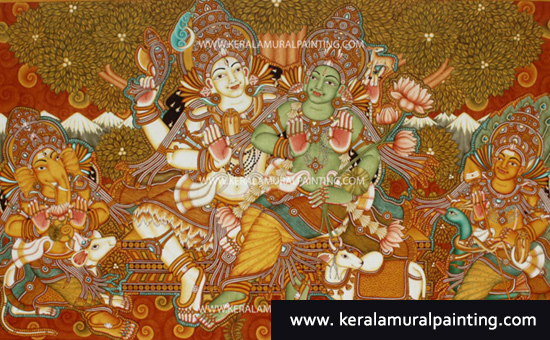
Credits
To read all
articles by author
All articles to
Indian Art
The
purpose of this compilation is to document and promote. We have given credits
and reference links in this compilation. In case some are missed, it is not
with malafide intent.
See pictures of
1. Ajanta Caves
2. Bundi Fort
Paintings
3. Bundela
Paintings Orchha
4. Paintings
Brihadesvara Temple Tamil Nadu